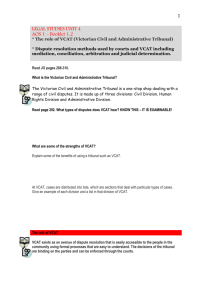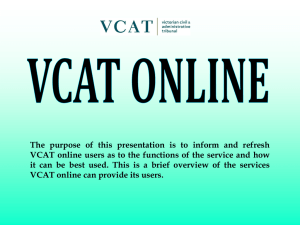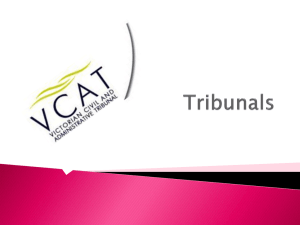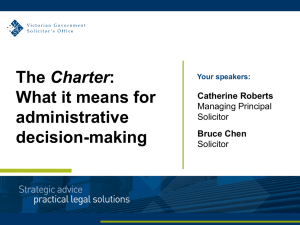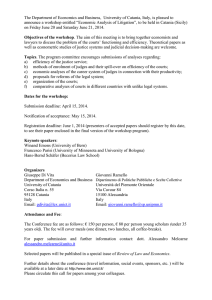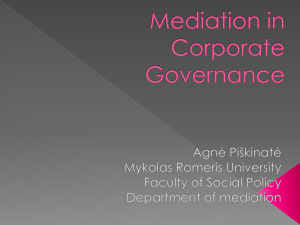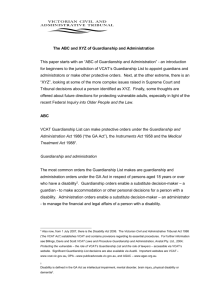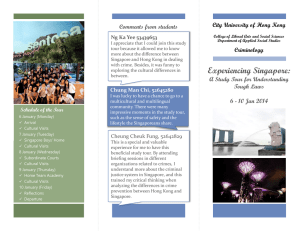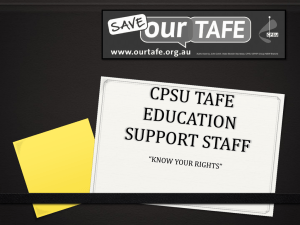Unit 4 Outcome 1 - Dispute Resolution- A comparison
advertisement
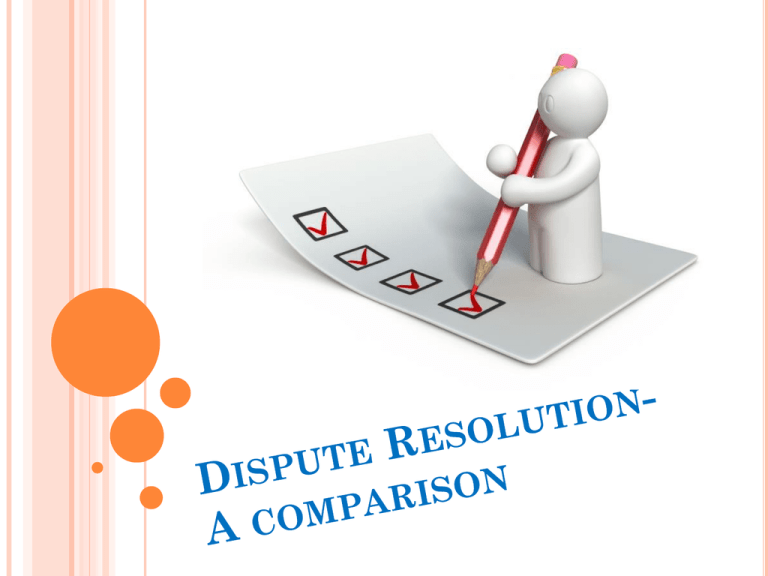
DISPUTE RESOLUTION- A COMPARISON The legal system presents individuals with a range of ways in which they can resolve disputes. Taking a case to court is a costly process. Of course there are some cases that must be heard by a court. Only a court can make a decision about the guilt or innocence of a defendant in a criminal case. In a civil dispute the individual can make a number of choices. In relatively minor matters an individual may choose not to take action. Alternative dispute settlement processes and tribunals can also be used to resolve civil disputes. Alternatively, in more complex cases the individual may decide to take the case to court. COURT ACTION & DRM Taking a civil dispute to court is usually seen as the last resort. The court system uses an adversarial process to reach a judicial determination. This includes strict rules of evidence and procedure. Furthermore, the formality of the process means that legal representation is required. Therefore, going to court to resolve a civil dispute is costly and time-consuming. However, the courts do have the power to make a final binding decision. Court may also refer parties to other forms of dispute resolution such as mediation and arbitration. The Magistrates’ Court also uses conciliation and compulsory arbitration in civil disputes involving less than $10 000. Dispute resolution methods and VCAT The use of mediation, conciliation and arbitration in VCAT are usually a more cost effective way to resolve a civil dispute. These methods are generally less formal, less time-consuming, less costly and less intimidating. Dispute resolution methods used by VCAT can potentially provide a more satisfactory resolution of a dispute. In many instances the parties reach a mutual agreement. This is sometimes described as a ‘win/win’ situation. The parties are able to discuss issues, explore possible solutions and reach a decision. STRENGTHS OF COURTS Courts provide a binding resolution of disputes. Courts use different dispute resolution methods to resolve disputes. They can use mediation, arbitration and judicial determination. If the mediation occurs as part of a court action, the agreement may be included in court orders, which are legally enforceable. Courts can adjudicate on a range of civil and criminal disputes and provide a binding resolution. ● Courts can adjudicate on a range of civil and criminal disputes. The court hierarchy enables courts to specialise in hearing specific types of cases such as family law, taxation and constitutional matters and so develop appropriate procedures to effectively settle the dispute. For instance, the Magistrates’ Court hears minor summary offences and civil matters under $100 000. The High Court hears constitutional matters. ● Courts use legal representation to prepare and present the case. The use of legal representation ensures that both parties are treated equally and each party has the opportunity to present their side of the facts in an objective, reasoned argument. ● Courts follow strict rules of evidence and procedure. Strict rules of evidence maintain consistency in how our courts determine the truth. ● Courts are bound by the principles of natural justice. Natural justice refers to every person entitled to a fair and unbiased hearing. Courts must remain impartial at all times. Both parties are considered equal before the law. WEAKNESSES OF COURTS Courts are very expensive. Courts are very expensive due to the high court costs and the need for legal representation for the preparation and presentation of a case. The unsuccessful party in a civil matter has to consider the possibility of paying large amounts in compensation, party– party costs and court costs. Even the successful party will be out of pocket as the award will not cover all their solicitor–client costs. This may prevent or discourage some parties from pursuing a valid civil claim through the courts. Court cases are time-consuming. Preparation and pre-trial proceedings take up a lot of time. Individuals may not be able to afford legal representation. Individuals who are unable to afford their own legal representative and are ineligible for legal aid are at a huge disadvantage in the court system. Applications for legal aid must pass both a means test (to assess their ability to pay for their own private legal representation) and the merit and reasonableness test (the likelihood of being successful in their case and whether it is reasonable for them to fund the case) in order to be eligible for legal aid. Not always the most appropriate method. Judicial determination creates a situation there is a ‘winner’ and a ‘loser’. This may not be appropriate where there is an ongoing relationship between disputing parties. For instance, if the dispute is between neighbours, the ‘winner’ and ‘loser’ outcome may in fact escalate the dispute in the future rather than settle it. STRENGTHS OF VCAT Less costly. VCAT provides an efficient, low-cost, informal and less intimidating access to high-quality dispute resolution and decisionmaking of civil cases. The cost of applying for a dispute to be heard before VCAT is far cheaper than taking a case to court. For instance, the fee for a small claim (involving an amount of less than $10 000) is $35.20. In small claim cases the parties must represent themselves and so there is no need for representation.. Less intimidating. VCAT is a less intimidating form of dispute resolution, compared to courts, due to the absence of strict rules of evidence and procedure. Hearing of evidence and examination of witnesses is less formal. VCAT is faster. VCAT provides for a more timely resolution of disputes. As the hearings are generally less formal there are fewer pre-hearing requirements in preparing a dispute to go before VCAT. If the parties cannot reach a decision, VCAT will make a decision. VCAT hearings are conducted in a less formal manner. VCAT does not use the strict rules of evidence and procedure used by courts. The parties are given the opportunity to put their case in their own words. The parties are encouraged to reach an agreement themselves. VCAT can use mediation or conciliation to encourage the parties to reach an agreement. If the parties cannot, the matter will go to arbitration and a binding decision will be handed down. WEAKNESSES OF VCAT VCAT is usually suitable for minor disputes. Not used in criminal matters. Larger civil disputes proceed through the court system. Escalating cost of VCAT hearings. The cost of VCAT hearings has escalated in recent years. This is due to an increase in the number of people using legal representation. All VCAT lists, except civil claims, allow the parties to be legally represented if they both agree or where certain circumstances exist. As a result some costs of taking a claim to VCAT have increased due to the use of legal representation. Parties cannot reach an agreement. Mediation and conciliation decisions are not legally binding. An individual may compromise too much to settle the dispute. They may feel intimidated or manipulated by a stronger party. Limited right of appeal An appeal can only be made on a point of law. While this has the advantage of restricting further costs, parties to a dispute decided in VCAT have limited rights to have a decision reviewed. EVALUATING THE STRENGTHS AND WEAKNESSES 1) 2) 3) 4) 5) 6) 7) 8) 9) There are a number of questions that an individual should consider in deciding which method to use. How formal is the process? How long will it take? How much will it cost? Do I need a lawyer? Who makes the decision? Is the decision binding? What impact will it have on my relationship with the other party? Will the other party attend? Is there a right of appeal? SUMMARY EVALUATION OF THE COURTS AND VCAT Copy the table from 314 into your books. STRENGTHS AND WEAKNESSES OF COURTS AND VCAT Get ready for some writing, because we are going to be answering this question on the board. QUESTION TIME Complete Questions 1-3 on page 315. Complete the Practice Exam Questions on page 315.

